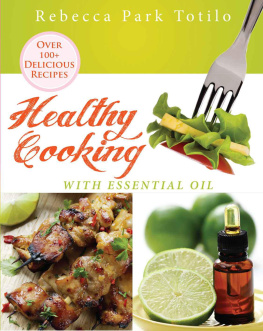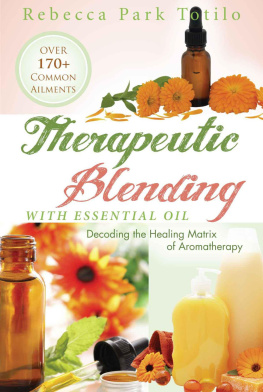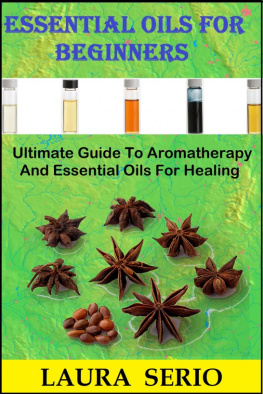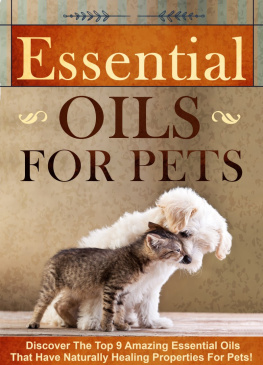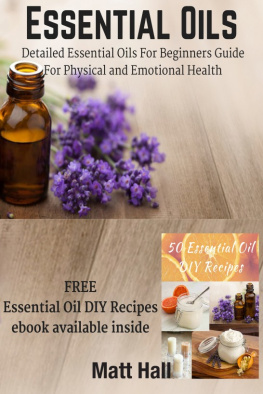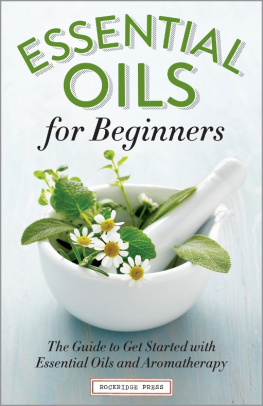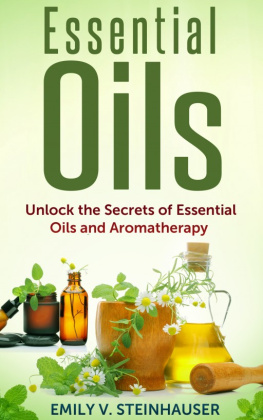Contents
Healthy Cooking with Essential Oil
Rebecca Park Totilo
Healthy Cooking with Essential Oil
Copyright 2015 by Rebecca Park Totilo
All rights reserved. No part of this book may be reproduced or transmitted in any form or by any means without written permission of the author.
Printed in the United States of America.
Published by Rebecca at the Well Foundation, PO Box 60044, St. Petersburg, Florida 33784.
No part of this publication may be reproduced, stored in a retrieval system or transmitted in any form by any meanselectronic, mechanical, photocopy, recording or otherwisewithout written permission of the copyright holder, except as provided by USA copyright law.
Disclaimer Notice: The information contained in this book is intended for educational purposes only and is not meant to substitute for medical care or prescribe treatment for any specific health condition. Please see a qualified health care provider for medical treatment. We assume no responsibility or liability for any person or group for any loss, damage or injury resulting from the use or misuse of any information in this book. No express or implied guarantee is given regarding the effects of using any of the products described herein.
ISBN 978-0-9898280-5-5
Chapter 1
The Joy of Cooking with Essential Oil
Can you imagine opening the doors to a whole new world of cooking, unleashing new dimensions of sensory pleasure? Aromatherapy can enhance your culinary creations in a multitude of ways, using essential oils to add more than just fragrance or flavor. Food is not merely fuel; it can be enjoyed as a multi-sensory experience that brings therapeutic value as well as nourishment.
The virtues of essential oils are well known, but their benefits extend beyond the treatment room. Cooking with essential oils can open up a wealth of creative opportunities in the kitchen. For years we have limited the use of essential oils to scented candles and massage oils, in the belief that they are unsafe to consume. But the tide is turning more and more people are realizing the value of using essential oils to enhance our food.
Ancient civilizations recognized this a long time ago, understanding the power of essential oils to add depth and flavor to their food. Modern society lost these ancient cookery traditions as synthetic substitutes became more popular. Recent generations have missed out on the amazing sensory experience of cooking with essential oils, which not only produces delicious creations but also enhances the entire cooking process from start to finish. Just one or two drops can transform your kitchen into a fragrant paradise, filled with mouth-watering aromatic treats to delight the senses.
The beauty of essential oils is that only a tiny amount is needed to transform your dish from rather plain to something truly amazing. Being highly concentrated, every drop is a little powerhouse of flavor and packed with natural goodness. From condiments to desserts and drinks, almost any recipe can be enhanced with the right oil experimentation is all part of the fun!
The aroma of food can account for as much as 90% of its perceived flavor. Essential oils can be used to add aromatic depth, providing new flavors that can be as strong or as subtle as desired. Think of it as just another way of adding seasoning to your food, like herbs and spices.
But essential oils offer more than just fragrance and flavor their therapeutic qualities can actually help to improve your overall wellbeing, as well as making your food taste delicious. Unlike other cooking oils, essential oils are fat-free.
Salad dressings, dips and marinades are good places to start for beginners. A drop of an herbal essential oil can replace around one tablespoon of fresh herbs as a general guideline. You will be amazed at the powerful flavors that such a tiny amount of essential oil can add to a recipe the merest hint is sometimes all it takes to really add the wow factor to a dish. Your dinner guests will love the sensory experience!
You might still feel uneasy about consuming essential oils after all, it goes against our instincts to drink substances that we are led to believe are toxic. But if you chew gum or use toothpaste it is likely that you have already consumed essential oils without realizing it, as they are commonly used in the confectionery industry to add flavor. And if youve enjoyed a glass of Coca-Cola recently, you might be interested to learn that its secret recipe contains 16 different essential oils, including vanilla, cinnamon, orange and lime.
The FDA has published an extensive list of essential oils that are safe to consume in small doses. While some do contain toxic components, the miniscule amounts used in cooking render them to be harmless. Many common store-cupboard ingredients are toxic at high doses but considered to be safe in moderation such as salt, which is found in almost every kitchen. As long as you are using pure therapeutic quality oils, you can rest assured that they are suitable for consumption.
Aromatherapy harnesses the wonderful natural power of essential oils, so incorporating them into your everyday cooking is a great way to enjoy their therapeutic properties. The act of cooking itself will be enhanced by the fragrant pleasure of adding essential oils, soothing the mind or reinvigorating the senses. What could be more enjoyable than spending time in the kitchen surrounded by wonderful aromas, creating delicious food for you and your loved ones?
Many people are unfamiliar with essential oils or unsure how to use them safely in cookery. This guide is designed to demystify the concept of adding essential oils to food, hopefully inspiring you to leap into the kitchen and begin experimenting to create your own aromatic delights! The opportunities are truly endless. If you have been missing out on this wonderful sensory experience its time to get cooking!
When you use essential oils in the kitchen, there is no end to the interesting tastes you can create
Valerie Ann Worwood, Aromatherapist and author of The Complete Book of Essential Oils and Aromatherapy
Chapter 2
What Is An Essential Oil?
Essential oils are fragrant, vital fluids distilled from flowers, shrubs, leaves, trees, roots, and seeds. Technically, they are actually not oil at all, but are volatile organic compounds made up of a variety of chemicals.
Essential Oil vs. Vegetable Oil
Since essential oils are derived from a natural plant source, you will notice that the oil does not leave an oily or greasy spot. This is because essential oils do not contain any lipids, unlike fatty vegetable oils used in cooking, such as olive, flax, coconut, avocado, or canola. Vegetable oils, on the other hand, are 100% fat and contain glycerol, which leaves a greasy residue. Vegetable oils are important to our health as well, as they contain fatty acids essential for bodily functions that the body cannot produce on its own.
While both essential oils and vegetable oils have many health benefits, essential oils offer a holistic alternative to vegetable oils in many ways:
- Essential oils unique chemistry makeup enables them to be able to permeate every cell and administer healing at the most fundamental level of our body.
- Essential oils structural complexity enables them to perform various functions with just a few drops of oil. Essential oils are steam distilled from plants (with the exception of citrus oils which are cold-pressed).
Essential Oil vs. Dried Herbs
Essential oils are extremely concentrated with more intense flavor more than 50 to 70 times more potent than the fresh or dried herb they are derived from! Because of their potency, you will never want to add more than a drop or two at a time to a recipe (unless the recipe instructs otherwise). In comparison to dried herbs, adding 1/2 teaspoon to a recipe is quite common and may not seem like much, however, with essential oils a teaspoon is approximately 76 drops, which is quite a lot. In fact, just one drop of peppermint oil is equivalent to approximately 28 cups of tea. And when you consider it only takes a few leaves of peppermint to make tea, it takes five pounds of leaves to make one ounce of essential oil.

